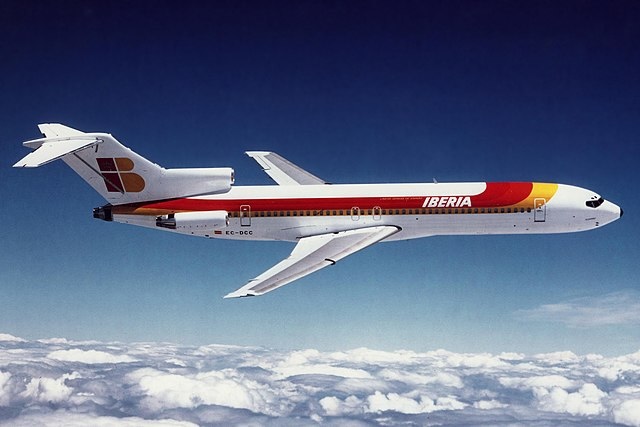Boeing 727
Summary
| Category | Transport aircraft |
| Origin country | 🇺🇸 United States |
| First flight | 9 February 1963 |
| Year of introduction | 1964 |
| Number produced | 1832 units |
| Average unit price | $5 million |
Description
The Boeing 727's development originated from the requirements of United Airlines, American Airlines, and Eastern Air Lines for an airliner capable of serving smaller cities with shorter runways. United sought a four-engine design for high-altitude airport operations, while American preferred a twin-engine aircraft for efficiency. Eastern required a third engine for overwater Caribbean flights, influenced by regulations limiting twin-engine flights to routes within 60 minutes of an airport. These divergent requirements led to an agreement on a trijet configuration. Boeing ultimately proceeded independently with the design. Pratt & Whitney's JT8D turbofan engine became the exclusive powerplant for the aircraft. The 727-100 first flew on February 9, 1963, received FAA type approval, and entered service with Eastern Air Lines on February 1, 1964. Production of the 727 concluded in 1984, with 1,832 aircraft built and 1,831 delivered.
The 727 is a trijet aircraft powered by three Pratt & Whitney JT8D low-bypass turbofans positioned below a T-tail. One engine is mounted on each side of the rear fuselage, with a center engine fed through an S-duct beneath the tail. The fuselage has an outer diameter of 148 inches, permitting six-abreast seating with a single aisle when using 18-inch-wide coach-class seats. The lower fuselage lobe features a 10-inch height difference between the forward and aft sections relative to the wing. Designed for independent operation at smaller airports, the 727 incorporates a built-in airstair that deploys from the rear underbelly of the fuselage and an auxiliary power unit (APU). A retractable tailskid is included to protect against over-rotation during takeoff. The wing design features leading-edge devices such as Krueger flaps on the inner wing and extendable leading edge slats outboard, alongside triple-slotted, Fowler flaps on the trailing edge, achieving a maximum wing lift coefficient of 3.0 to facilitate shorter runway operations.
The Boeing 727 was primarily designed for passenger and cargo transport. Its design features and the addition of a third engine contributed to its suitability for diverse routes. The aircraft became popular with passenger, cargo, and charter carriers. A convertible passenger-cargo version, the 727-100C, was developed featuring an additional freight door and strengthened floor, capable of carrying up to eight cargo pallets weighing 38,000 lb (17,000 kg). The 727-100QC (Quick Change) version included a roller-bearing floor for faster changeover times between passenger and cargo configurations. A freighter version of the 727-200 Advanced became available in 1981, designated the Series 200F Advanced, powered by Pratt & Whitney JT8D-17A engines. It featured a strengthened fuselage structure, an 11 ft 2 in (3.40 m) by 7 ft 2 in (2.18 m) forward main deck freight door, and a windowless cabin. Beyond its primary roles, a modified Boeing 727, known as 'Faw-727', was reportedly used by the Iraqi Air Force as an ELINT platform equipped with Thomson-CSF TMV-018 Syrel pods for ESM and Raphael-TH pods with side looking radar. Its capability to operate from airports with gravel or lightly improved runways made it valuable to certain airlines serving remote communities.
Main Variants:
-
727-100: The initial version designed for shorter runways and medium-range flights.
-
727-100C: A convertible passenger-cargo version with an additional freight door and strengthened floor.
-
727-100QC: Similar to the convertible version but with a roller-bearing floor for faster conversions.
-
727-200: A stretched version, 20 feet longer than the -100, allowing for increased passenger capacity.
-
727-200 Advanced: Introduced in 1970 with more powerful engines, increased fuel capacity, and a higher MTOW, resulting in extended range.
Technical specifications
| Version: 727-200 | |
|---|---|
| Wing area | 157.9 m² (1699.9 sqft) |
| Wingspan | 33 m (108.3 ft) |
| Height | 10 m (32.8 ft) |
| Length | 46.7 m (153.2 ft) |
| Service ceiling | 12802 m (42001 ft) |
| Empty weight | 45359 kg (99999 lbs) |
| Max. takeoff weight | 95028 kg (209501 lbs) |
| Takeoff distance | 1768 m (5801 ft) |
| Powerplant | 3 × turbojets Pratt & Whitney JT8D-9A delivering 6577 kgp |
Current operating countries
| Country | Units | ||
|---|---|---|---|
|
|
Colombia | 1 | |
| 🇨🇩 | Congo Democratic Republic | 1 | |
|
|
Ecuador | 1 | |
Numbers in parentheses, e.g. '(+5)', indicate units ordered but not yet delivered.
All operators
Belgium • Congo Democratic Republic • Colombia • Djibouti • Ecuador • Greece • Iran • Kuwait • Liberia • Mexico • Mauritania • Nigeria • New Zealand • Panama • Qatar • Senegal • Taiwan • United States • Yemen • Ex-Yugoslavia
Photo of 727
